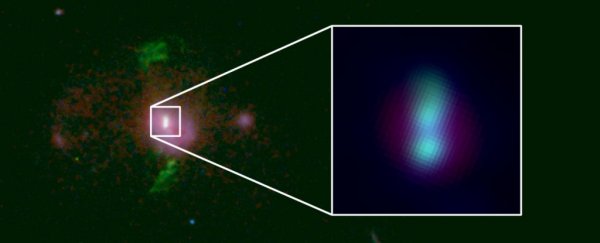Thanks to gravitational wave astronomy, we are getting a better understanding of what happens when black holes collide. But the closely orbiting black holes only generate ripples in space-time strong enough to be detected from just before they smash. What happens before then? We can only extrapolate.
But a new discovery could change all that. In a galaxy just over 2.5 billion light-years away, astronomers have spotted two supermassive black holes destined for a colossal smash-up.
Don't get too excited. They're still pretty far apart, and astronomers estimate that it could take another 2.5 billion years for them to meet. But there's still a lot we can learn from them, even if we won't be around to see the fireworks.
The biggest promise of this discovery is getting us closer to discerning the gravitational wave background, a hypothetical hum of low-frequency gravitational waves from sources like supermassive black holes just about to merge.
We are yet to detect this noise - it's outside the range of our current instruments. But now that we have an actual pair of supermassive black holes in our sights, their characteristics provide astronomers with an estimate of how many such pairs could be out there, potentially making this gravitational wave background noise.
"It's a bit like a chaotic chorus of crickets chirping in the night," said astrophysicist Andy Goulding of Princeton University. "You can't discern one cricket from another, but the volume of the noise helps you estimate how many crickets are out there."
Having a grasp on this noise could eventually help us figure out whether supermassive black holes even merge at all.
So far, our black hole collision detections have been of much less dramatic stellar-mass black holes; the most powerful gravitational wave detection to date was a collision between black holes 50 and 34 times the mass of the Sun, respectively.
Supermassive black holes are another category altogether. Each one in this newly discovered pair is estimated to be 400 million times the mass of the Sun; and each is the nucleus of a galaxy, the two coming together in a galactic collision.
What will the nucleus of that final galaxy look like? Will it be one giant supermassive black hole 800 billion times the mass of the Sun, or, as they draw closer together, will the two black holes become stuck in a perpetual orbit with each other?
"It's a major embarrassment for astronomy that we don't know if supermassive black holes merge," said astrophysicist Jenny Greene of Princeton University. "For everyone in black hole physics, observationally this is a long-standing puzzle that we need to solve."
According to theoretical modelling, when two galaxies merge, their black holes are inexorably drawn together, transferring their orbital energy to the gas and stars around them, and thus orbiting in a tighter and tighter spiral.
We know that pairs of stellar-mass black holes will eventually come together and form a single object, but with supermassive black holes, there's a problem.
As their orbit shrinks, so too does the region of space to which they can transfer energy. By the time they're one parsec apart (around 3.2 light-years), theoretically this region of space is no longer large enough to support further orbital decay, so they remain in a stable binary orbit - potentially for billions of years. This is called the final parsec problem.
If we could see a binary galactic nucleus, we could resolve that problem, but at a distance of one parsec, colliding black holes would be way too close to each other to tell apart (although one candidate has been spotted)… and, well, you know how hard it is to see a black hole at all.
This newly discovered pair is still around 430 parsecs (1,400 light-years) apart, so they won't directly solve the final parsec problem - but they are still useful as they have given researchers a better estimate of how long it takes before such a collision would start producing detectable gravitational waves.
We're not there yet. But by analysing this newly discovered black hole pair in the context of a hypothetical gravitational wave background, the team was able to arrive at an estimate of around 112 merging supermassive black holes within detection distance of Earth.
That's a good-enough quantity close to us that we might have the first gravitational wave background detection in a few years.
If the gravitational wave background is full of noise from supermassive black hole pairs, then somehow, they do indeed manage to close that final parsec between them.
And, if we don't detect that noise, maybe that parsec really does remain insurmountable.
The research has been published in The Astrophysical Journal Letters.
